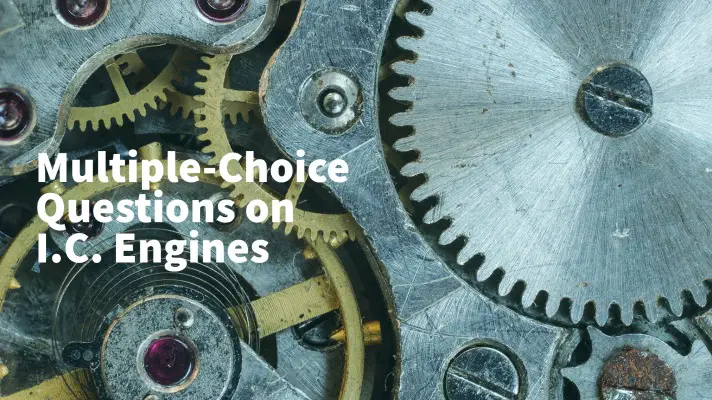Are you looking for Multiple-Choice Questions on IC Engines? In this article, I will show you some MCQ questions that will boost you in examinations and also in viva. Even during the job interviews, it will help you.
In the last section, there will be a Quiz of 10 marks on IC Engines. Appear for the test and evaluate yourself.
To download this MCQ sheet, you have to reach the end of this page. There you will find a PDF downloadable button. Click here and download the PDF version of this sheet.
So now let’s start the objective-type questions or viva questions on I.C. Engines.

MCQ questions or Viva Questions on IC Engine
- In an I.C Engine, the combustion of fuel takes place ____.
- Outside the engine cylinder
- Inside the engine cylinder
- Both (1) and (2)
- None of these
Ans: (2)
- Efficiency of an I.C Engine is ____.
- 15-20%
- 20-25%
- 35-40%
- 45-60%
Ans: (3)
- I.C engine runs on ____.
- Otto cycle
- Diesel cycle
- Both (1) and (2)
- Rankine cycle
Ans: (3)
- The heart of an I.C engine is ____.
- Cylinder head
- Piston
- Connecting rod
- None of these
Ans: (2)
- Which part of the IC engine transmit force from the piston to the crankshaft?
- Piston
- Crankshaft
- Flywheel
- Connecting rod
Ans: (4)
- Which part of the IC engine helps in maintaining a constant speed?
- Piston
- Crankshaft
- Flywheel
- Connecting rod
Ans: (3)
- In general, how much pressure does the engine cylinder withstand?
- 20 bar
- 50 bar
- 90 bar
- 150 bar
Ans: (2)
- In general, how much temperature does the engine cylinder withstand?
- 2200 Degree C
- 1200 Degree C
- 200 Degree C
- 20 Degree C
Ans: (1)
- In which of the following sequence, IC engine works?
- Suction, Expansion, Compression, Exhaust
- Expansion, Suction, Compression, Exhaust
- Suction, Compression, Expansion, Exhaust
- Suction, Exhaust, Compression, Expansion
Ans: (3)
- The full form of S.I Engine is ____.
- Standard Injection Engine
- Special Ignition Engine
- Spark Ignition Engine
- Special Injection Engine
Ans: (3)
- The full form of C.I Engine is ____.
- Internal Combustion Engine
- Compression Ignition Engine
- Compact injection Engine
- Compact Ignition Engine
Ans: (2)
- The full form of IC Engine is ____.
- Internal Combustion Engine
- Compression Ignition Engine
- Compact injection Engine
- Compact Ignition Engine
Ans: (1)
- How many revolutions occur in a two-stroke engine?
- 1
- 2
- 3
- 4
Ans: (1)
- How many revolutions occur in a four-stroke engine?
- 1
- 2
- 3
- 4
Ans: (2)
- In two revolutions of a two-stroke engine, how many power stroke will you get?
- 1
- 2
- 3
- 4
Ans: (2)
- In two revolutions of a four-stroke engine, how many power stroke will you get?
- 1
- 2
- 3
- 4
Ans: (1)
- Which of the following engine has higher thermal efficiency?
- Two-stroke engine
- Four stroke engine
- Efficiency of both engines are same
Ans: (2)
- In which engine, exhaust gases create noise?
- 2-stroke engine
- 4-stroke engine
- None of these
Ans: (1)
- Which of the following engine has lower compression ratio?
- Diesel engine
- Any C.I engine
- Petrol engine
- Both (1) and (2)
Ans: (3)
- The pressure at the end of compression is about ____ bar in Petrol engine.
- 10 bar
- 35 bar
- 55 bar
- 65 bar
Ans: (1)
- The pressure at the end of compression is about ____ bar in C.I engine.
- 10 bar
- 35 bar
- 55 bar
- 65 bar
Ans: (2)
- Which of the following engine has lower compression ratio?
- S.I engine
- C.I engine
- Petrol engine
- Both (1) and (3)
Ans: (4)
- The purpose of carburettor is ____.
- To mix air and fuel in the required proportion
- To supply air during suction
- To make an efficient exhaust
- None of these
Ans: (1)
- Scavenging is ____.
- The process of admitting air
- The process of replacing the exhaust gas
- Both (1) and (2)
- None of these
Ans: (3)
- The knocking tendency of fuel in S.I engines is expressed by ____.
- Octane number
- Cetane number
- Both (1) and (2)
- None of these
Ans: (1)
- The knocking tendency of fuel in C.I engines is expressed by ____.
- Octane number
- Cetane number
- Both (1) and (2)
- None of these
Ans: (2)
- A fuel of octane number 75 means ____.
- 25% iso-octane and 75% normal heptane
- 25% cetane and 75% alpha-methyle-napthalene
- 75% iso-octane and 25% normal heptane
- 75% alpha-methyle-napthalene and 25% iso-octane
Ans: (3)
- A fuel of Cetane number 75 means ____.
- 25% iso-octane and 75% normal heptane
- 25% cetane and 75% alpha-methyle-napthalene
- 75% iso-octane and 25% normal heptane
- 25% alpha-methyle-napthalene and 75% cetane
Ans: (4)
- Supercharging is ____.
- The process of replacing the exhaust gas
- The process of admitting air
- The process of increasing the density of air fuel mixture
- None of these
Ans: (3)
- Theoretically, the correct ratio of air and petrol in the mixture is ____.
- 2:1
- 5:1
- 10:1
- 15:1
Ans: (4)
- The thermodynamic cycle on which the petrol engine runs is:
- Otto cycle
- Rankine cycle
- Joule cycle
- None of these
Ans: (1)
- How can you reduce the knocking tendency in a petrol engine?
- By increasing the compression ratio
- By changing the ratio of air and fuel
- By reducing the compression ratio
- By changing the ignition timing
Ans: (3)
- Which of the following parts relates to diesel engine?
- Carburator
- Spark plug
- Ignition coil
- Fuel injector
Ans: (4)
- By which of the following, you can determine the indicated power of each cylinder of an I.C. Engine?
- Universal testing machine
- Morse test
- None of these
Ans: (2)
- The Morse test is used to calculate the indicated power of ____.
- Single cylinder petrol engine
- Double cylinder diesel engine
- Double cylinder petrol engine
- Multi cylinder engine’
Ans: (4)
- Which of the following statesman is true?
- F.P. = I.P. +B.P.
- F.P. = I.P.-B.P.
- B.P.=I.P.+F.P.
- None of these
Ans: (2)
- Which of the following ratio defines the compression ratio?
- Total volume of cylinder / clearance volume
- Clearance volume / total volume of cylinder
- Total voume of a cylinder / (total volume – clearance volume) of the cylinder
- None of these
Ans: (1)
- The mechanical efficiency of an I.C. Engine is ____.
- I.P./B.P.
- F.P./B.P.
- B.P./I.P.
- B.P./F.P.
Ans: (3)
- The air standard efficiency of a petrol engine is dependant on ____.
- Compression ratio
- Cut-off ratio
- Both (1) and (2)
- None of these
Ans: (1)
- The air standard efficiency of a diesel engine is dependant on ____.
- Compression ratio
- Cut-off ratio
- Both (1) and (2)
- None of these
Ans: (3)
Quiz on IC Engine
Here, is the quiz for you:
Conclusion
I hope that these MCQ Questions on IC Engines will help you in achieving a good score in your college/university examinations. If you want the objective-type questions on any other topic, please let me know by writing in the comment box so that I can provide you the same. Best Wishes!


